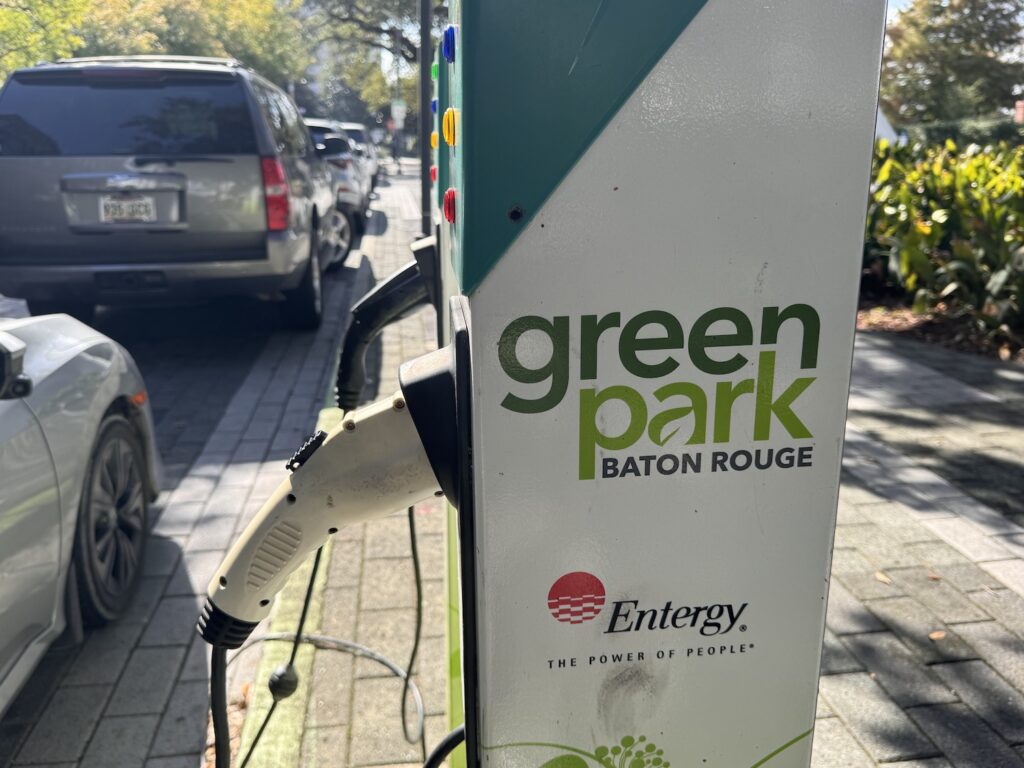
While electric vehicle ownership in Louisiana is low, the state is seeing rapid growth in the availability of EV chargers, according to a new report. Pictured is a public charger in downtown Baton Rouge. (Terry L. Jones/Floodlight)
Although electric vehicles make up less than 1% of the cars traversing Louisiana roadways, the state took the No. 2 spot in a recent report that tracked charging station growth in the past year.
An annual report from Zutobi, an international online driver’s education platform, claims that the Bayou State’s EV charging infrastructure experienced a nearly 50% growth between 2023 and 2024, with the number of charging stations going from 475 to 709. Louisiana was behind Connecticut, which experienced a 55% growth in EV charging stations year-to-year, and above Delaware, which experienced a 42% growth.
But local EV advocates say Louisiana’s growth seems substantial because there were so few chargers in the state to begin with. And the state is still lagging behind the rest of the country when it comes to installing public EV chargers. One reason: It still hasn’t rolled out the $73 million worth of charging infrastructure it received under the Biden Administration’s National Electric Vehicle Infrastructure Program (NEVI).
“We won’t see those chargers installed until, optimistically, the fall of next year,” said Tyler Herrmann, the co-director of Louisiana Clean Fuels, a nonprofit that’s part of the U.S. Department of Energy’s Clean Cities and Communities coalition. “I think things in Louisiana are — I usually like to say — they’re moving faster than you’d expect, but not as fast as we’d like.”
GET THE MORNING HEADLINES.
Herrmann said the NEVI money came with certain stipulations and benchmarks that the U.S. Department of Transportation’s Federal Highway Administration took over a year to finalize after the state allotments were announced.
Instead of waiting for the final stipulations, Herrmann said a lot of states started issuing requests for proposals after the preliminary drafts began circulating.
“So that put us probably six to eight months behind what most were doing,” he said.

The administration changes that followed when Republican Gov. Jeff Landry took office in January were another setback, but not because of any political foul play, Herrmann said.
Conservatives have been the most vocal opponents of EVs, and the transition away from gas-powered cars. And much of that opposition has been tied to political connections to the oil and gas industry. Opposition also has been ginned up by widespread misinformation about the cost and capabilities of electric vehicles.
But Herrmann said when it comes to Louisiana, “It was more of the logistics around the administration change. The people who are running the program were very high up within the (Louisiana Department of Transportation), so that had to be pushed off to new people who were in those positions.”
Zutobi’s report frames the billions of dollars the Biden administration is funneling toward EV infrastructure — and tax breaks and incentives to purchase electric vehicles — as a way to address the range anxiety that is still keeping many drivers from giving up their gas-powered vehicles.
The Biden Administration set a goal that at least half of the new vehicles produced annually by automakers be electrically-powered by 2030 as part of an effort to cut U.S. greenhouse gas emissions. It’s unclear what will happen to that when Donald Trump takes office in January.
On the campaign trail, Trump promised to do away with or roll back the EV-focused policies adopted under the current administration. But for now, electric vehicle adoption remains on an upward trajectory.
Last year, there were more than 1.45 million registered electrically-powered vehicles in the country, according to Zutobi’s report. That number jumped to more than 3.1 million in the past year. Oklahoma, Arkansas and Michigan experienced the most significant growth, thanks to the increase in public charging, growing consumer demand and state-level incentives, the report states.
And where EV registrations went up, charging infrastructure also did, but at a slower pace. In 2023, there were nearly 144,000 public charging stations, and in 2024, that increased to about 180,000.
“When charging is readily available, it makes the idea of owning an EV more practical,” said Hanna Mishchenko, a spokesperson for Zutobi. “Especially in rural areas, reliable access to charging stations alleviates range anxiety. And we all know that the U.S. is targeting to (increase sales) of EVs, but charging infrastructure is the first step to reach this goal.”
Alexia Melendez Martineau, a senior policy director for the nonprofit advocacy organization Plug In America, somewhat agrees with the sentiment. But she noted that most electric vehicles are charged at home, not at public charging stations.
“Public charging does not tell us the full picture,” Martineau said. “Fueling traditional gas cars — that is something we’re used to doing in the public sphere. With gas cars you need to be able to see a gas station to know your car is going to be able to get around.”
But she still credits the NEVI program and some states’ rapid implementation of those funds as local government responding to what they see is a rising consumer interest in EVs.
“One thing that’s challenging for folks to think about, is, we’re talking about infrastructure here,” she said. “Yes, we want to see this as fast as possible, but we also want these projects to be safe.”
YOU MAKE OUR WORK POSSIBLE.
Floodlight is a nonprofit newsroom that investigates the powerful interests stalling climate action.

